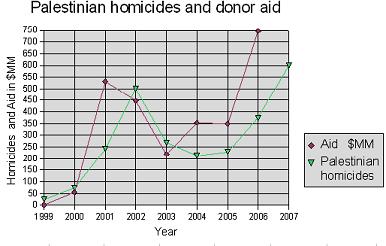Aid and Violence
Condi Rice has postponed the “Mid-East Peace Conference” scheduled for November 1st because participation by key players (other than the Israelis and Palestinians) is questionable. But when the conference does occur, you can bet that a key element will be Palestinian demands for significant increases in foreign aid.
CAMERA has conducted an interesting analysis that attempts to correlate financial aid given to Palestinians in Gaza and the West Bank (by the US, the EU, Israel via tax revenues, and others) and the number of homicides perpetrated by Hamas and Fatah in terrorist attacks and inter-group warfare. In their report, CAMERA notes:
Many commentators observing this outpouring of generosity towards the new Fatah-dominated government have expressed the need to proceed cautiously, noting the failure of prior aid to moderate Palestinian behavior, but few have provided specific information to substantiate their concern. In fact, a comparison of annual aid to the Palestinian government with the annual number of Palestinian homicides shows a worrisome correlation.
Statistics on Palestinian homicides and foreign aid to Gaza and the West Bank reveal that as aid increased to the Palestinian government, so too did the numbers of people killed by Palestinian militants.

From the summary graph, it appears that there is a direct and striking correlation between aid dollars given to the Palestinians and the number of homicides committed over the next year’s time.
CAMERA correctly notes that:
These statistics do not mean that foreign aid causes violence; but they do raise questions about the effectiveness of using foreign donations to promote moderation and combat terrorism. The graphs reveal that the increased budgetary aid to the Palestinian government after the start of the second Intifada in September 2000 was accompanied by a corresponding increase in the number of Palestinian homicides in 2001 and 2002. After mid-2002, Israeli countermeasures against suicide bombers began to reduce the number of Israeli dead. By August 2003, the first portion of the security barrier was in place, leading to a rapid decline in homicides in 2003. The appointment of Salam Fayyad, a moderate technocrat, to the finance ministry in late 2002 also resulted in reduced aid as Israeli tax revenue was restored to the Palestinian government. While Israeli countermeasures reduced the number of Israeli victims, Palestinian factional violence took an ever increasing toll. When including Palestinian victims of Palestinian violence as well as Israeli victims, the correlation between aid and homicides continues beyond 2003.
In the West, we tend to believe that poverty is a catalyst for terror and violence and that if we provide aid to help eliminate poverty, the terror and violence should be reduced. That doesn’t appear to be the case, at least in the Gaza and West Bank.
Part of the problem may be that the aid doesn’t get to the people who need it. The San Francisco Chronicle reports:
In an Atlantic Monthly article titled "In A Ruined Country," author David Samuels estimated that Arafat and his senior aides may have siphoned off as much as half of the $7 billion in aid to the Palestinian Authority. Samuels, citing an International Monetary Fund report, said Arafat may have personally taken $900 million just from 1995 to 2000, a figure that did not include the rake off from kickbacks and other forms of corruption.
There is relatively little evidence that things have improved significantly since Arafat's death. In fact, since the second intifada began, the economic plight of the Palestinians has degraded considerably, even though aid has increased significantly. Since Hamas was elected in Gaza, Hamas-Fatah violence has escalated dramatically.
Condi should remember that when the inevitable demands for more "humanitarian" aid begin.


<< Home